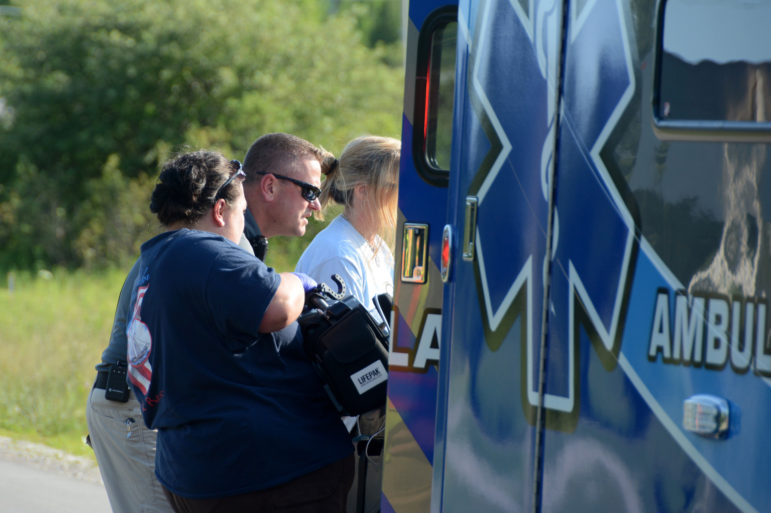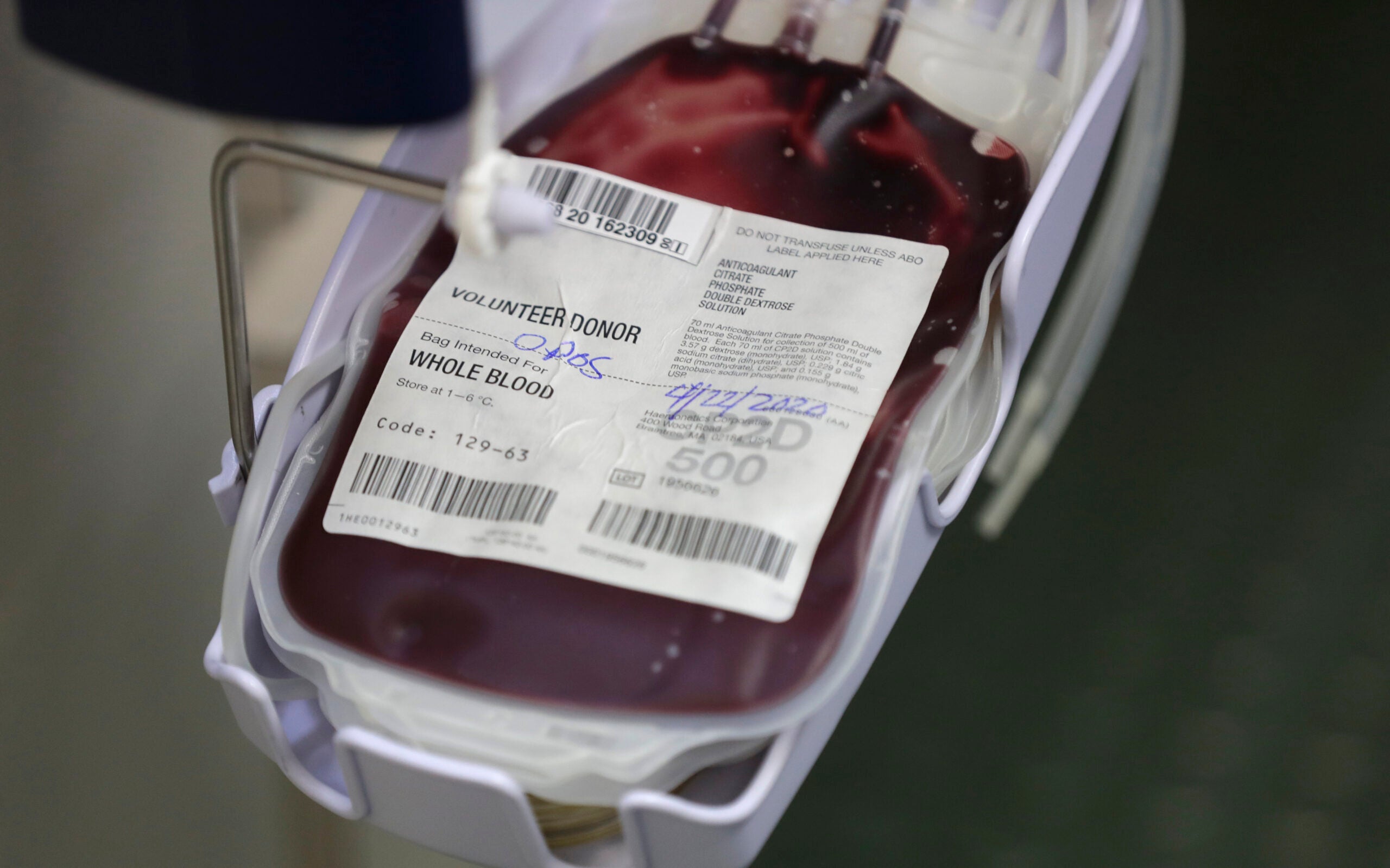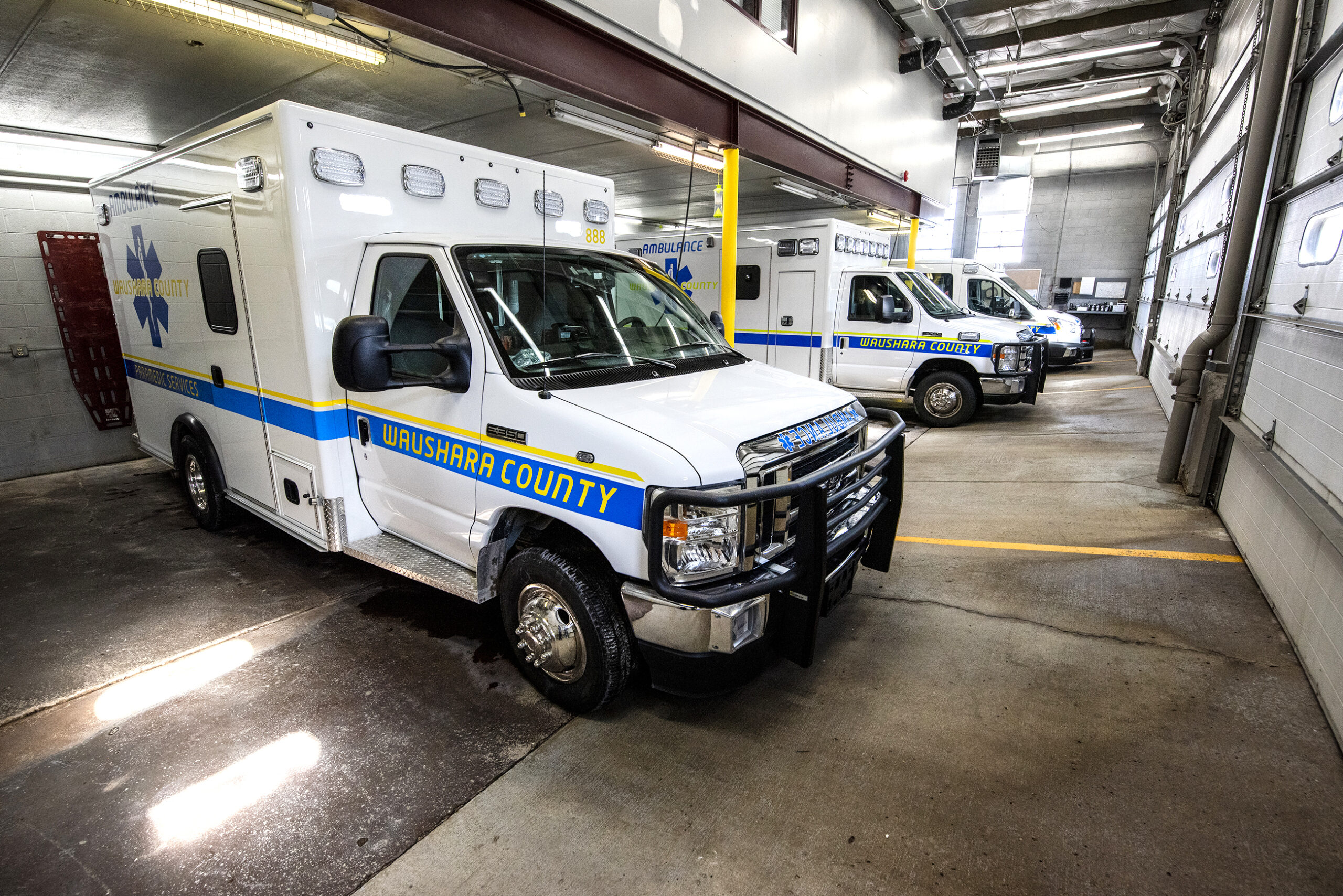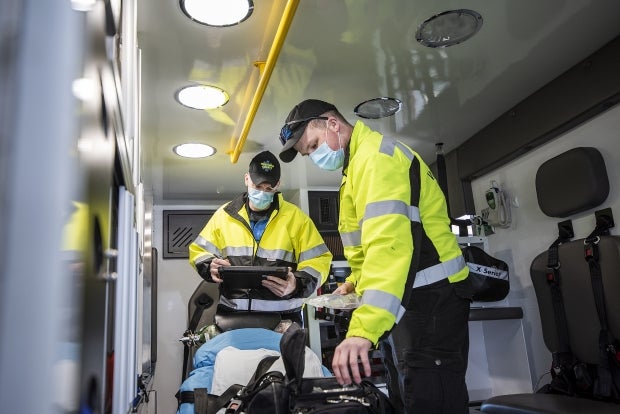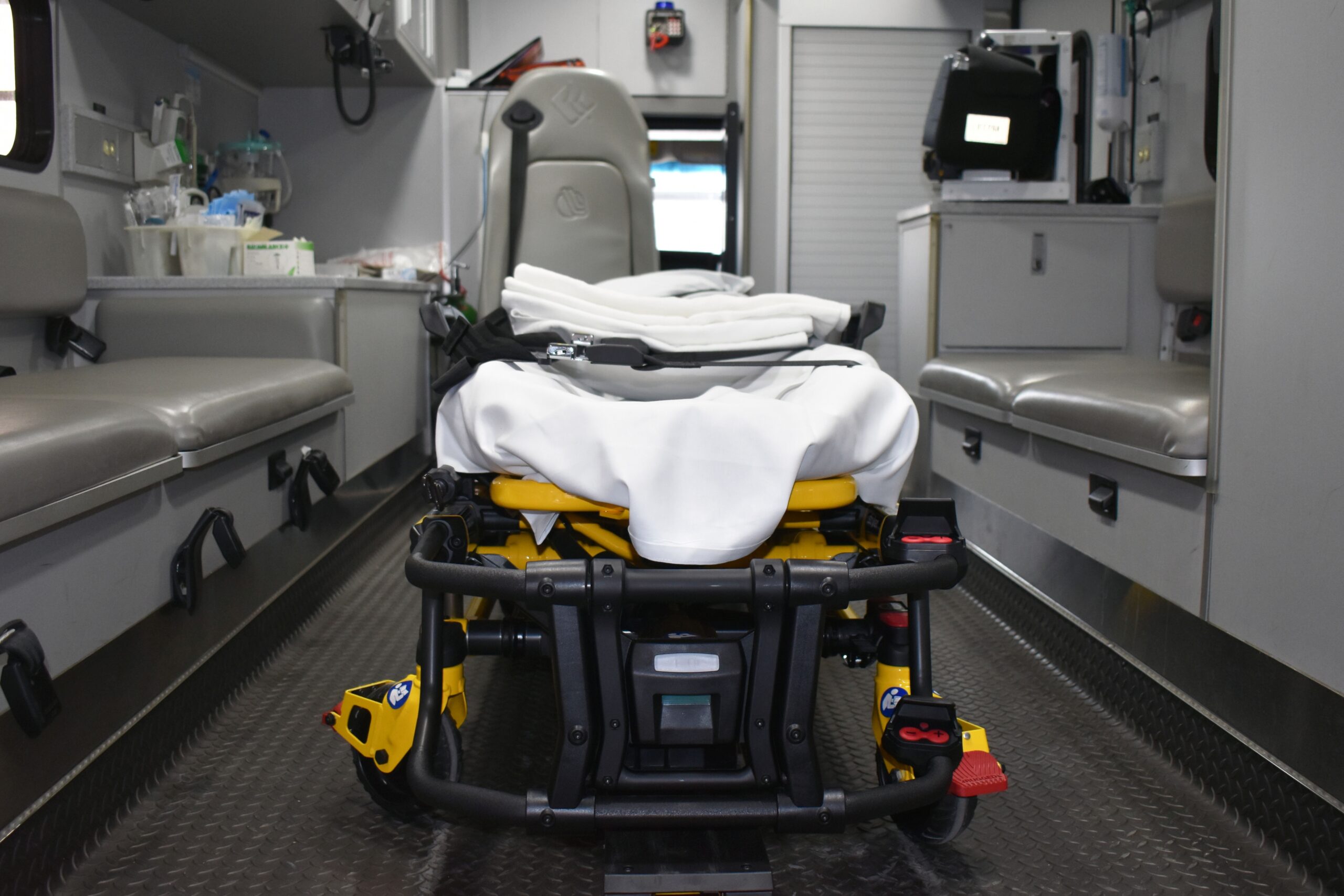The reality of the COVID-19 pandemic struck Rob Puls on March 19, when Bayfield County confirmed its first positive case of the virus.
Puls coordinates paramedics for Great Divide Ambulance, which staffs four ambulances around the clock in the 15,000-person county that hugs Lake Superior. The four vehicles cover around 730 square miles, an area three times the size of Chicago.
“I think everybody up here was shocked, because they thought we were rural and removed,” Puls said of the positive test, the first of the county’s three confirmed COVID-19 cases so far.
News with a little more humanity
WPR’s “Wisconsin Today” newsletter keeps you connected to the state you love without feeling overwhelmed. No paywall. No agenda. No corporate filter.
[[{“fid”:”1221256″,”view_mode”:”embed_portrait”,”fields”:{“format”:”embed_portrait”,”alignment”:”right”,”field_image_caption[und][0][value]”:”%3Cp%20class%3D%22wp-caption-text%22%3EGreat%20Divide%20Ambulance%20crew%20providers%20Taylor%20Heinzel%2C%20left%2C%20and%20Patrick%20Rogers%20who%20work%20in%20Bayfield%20County%2C%20Wis.%2C%20are%20seen%20here%20in%20their%20personal%20protective%20equipment.%20The%20crews%20now%20wear%20gloves%20and%20a%20face%20mask%20to%20every%20call.%20And%20when%20a%20patient%20has%20COVID-19%20symptoms%2C%20they%20additionally%20don%20N-95%20respirators%2C%20gowns%20and%20face%20shields.%20%3Cem%3EPhoto%20courtesy%20of%20Rob%20Puls%3C%2Fem%3E%3C%2Fp%3E%0A”,”field_image_caption[und][0][format]”:”full_html”,”field_file_image_alt_text[und][0][value]”:”Great Divide Ambulance crew providers Taylor Heinzel and Patrick Rogers who work in Bayfield County wear personal protective equipment.”,”field_file_image_title_text[und][0][value]”:”Great Divide Ambulance crew providers Taylor Heinzel and Patrick Rogers who work in Bayfield County wear personal protective equipment.”},”type”:”media”,”field_deltas”:{“2”:{“format”:”embed_portrait”,”alignment”:”right”,”field_image_caption[und][0][value]”:”%3Cp%20class%3D%22wp-caption-text%22%3EGreat%20Divide%20Ambulance%20crew%20providers%20Taylor%20Heinzel%2C%20left%2C%20and%20Patrick%20Rogers%20who%20work%20in%20Bayfield%20County%2C%20Wis.%2C%20are%20seen%20here%20in%20their%20personal%20protective%20equipment.%20The%20crews%20now%20wear%20gloves%20and%20a%20face%20mask%20to%20every%20call.%20And%20when%20a%20patient%20has%20COVID-19%20symptoms%2C%20they%20additionally%20don%20N-95%20respirators%2C%20gowns%20and%20face%20shields.%20%3Cem%3EPhoto%20courtesy%20of%20Rob%20Puls%3C%2Fem%3E%3C%2Fp%3E%0A”,”field_image_caption[und][0][format]”:”full_html”,”field_file_image_alt_text[und][0][value]”:”Great Divide Ambulance crew providers Taylor Heinzel and Patrick Rogers who work in Bayfield County wear personal protective equipment.”,”field_file_image_title_text[und][0][value]”:”Great Divide Ambulance crew providers Taylor Heinzel and Patrick Rogers who work in Bayfield County wear personal protective equipment.”}},”link_text”:false,”attributes”:{“alt”:”Great Divide Ambulance crew providers Taylor Heinzel and Patrick Rogers who work in Bayfield County wear personal protective equipment.”,”title”:”Great Divide Ambulance crew providers Taylor Heinzel and Patrick Rogers who work in Bayfield County wear personal protective equipment.”,”class”:”media-element file-embed-portrait media-wysiwyg-align-right”,”data-delta”:”2″}}]]Like other health care and essential workers, Puls’ crews have beefed up their use of personal protective equipment (PPE) as they try to stay safe during the pandemic. They now wear gloves and a face mask to every call. And when a patient has COVID-19 symptoms, they don N-95 respirators, gowns and face shields.
But most PPE is designed for temporary use, and replenishing those crucial supplies has proved incredibly difficult. When Puls called his supplier early in the pandemic, no one answered the phone.
“It just kept ringing,” he said. “They were inundated.”
And now? He hears an automated message along the lines of: “Don’t even ask us for protective equipment, because we have none.”
Protective gear shortages are growing more acute across Wisconsin as COVID-19 keeps spreading.
Dozens of hospitals have less than a week of PPE on hand, according to the Wisconsin Hospital Association. The state Department of Health Services has issued guidance on conserving supplies, saying it “expects continued PPE shortages.”
Unlike cities, which have full-time emergency medical responders on staff at the local fire department, Wisconsin’s rural emergency services typically rely on a patchwork of funding sources and volunteer labor. These rural services face particular challenges in paying for these crucial supplies — when they can find them.
WPR and Wisconsin Watch spoke to six rural Wisconsin emergency medical service providers who called the PPE shortage a top hurdle in responding to the pandemic. The departments are using creative solutions to find the gear, sometimes exhausting their tiny budgets once they do.
Wisconsin has received some outside help with equipment. In addition to a call out soliciting PPE, the state procured two shipments from the Strategic National Stockpile to distribute locally. Those include roughly 404,000 face and surgical masks, 248,000 pairs of gloves, 165,000 N-95 respirators, 79,000 face shields, 41,000 surgical gowns and 192 coveralls. A third shipment is on the way.
But it’s not enough.
“We’ve tried every vendor that we use. We’ve searched the internet. We’ve applied for supplies from the (national stockpile),” said Ryan Olson, director of ambulance services in the Barron County city of Chetek, population 2,100.
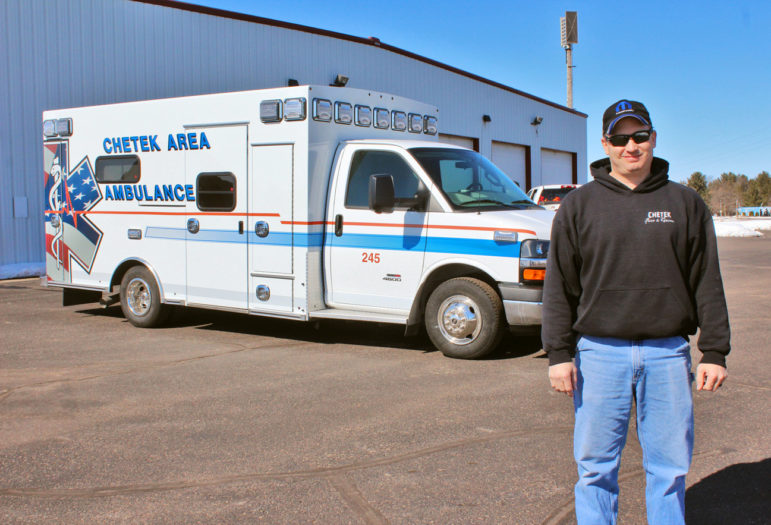
Help From Auto Shops, The Public
Wisconsin requires local governments of a certain size to offer fire services, but there is no requirement they provide emergency medical services. Volunteers make up nearly 40 percent of Wisconsin’s emergency medical workforce, and “almost all rural services rely on volunteers to some degree,” a DHS spokesperson said.
Keeping crews protected and healthy is particularly important for volunteer-run services.
Every rural EMS “struggles with staffing to begin with,” said Jim Aanstad, fire and ambulance chief of Iola, a village in Waupaca County that is home to three confirmed COVID-19 cases and one death. “You take four or five key people out of your roster, and you’re hurting big time.”
Volunteers run Iola’s ambulance service, which covers seven municipalities. They are paid, but very little. Even Aanstad has another job.
“If I don’t keep my people healthy, we’re not going to have anybody to respond to a call,” he said.
That is why obtaining protective gear is crucial. But departments struggle to bear the costs even when they manage to find the supplies. Many of Wisconsin’s emergency departments rely heavily on spaghetti suppers, pancake breakfasts and other unsteady funding sources, said Marc Cohen, executive director of the Wisconsin EMS Association. The finances of rural departments are particularly precarious.
The needs for PPE and other pandemic-related items are adding more than $20 to the cost of each ambulance response, Cohen wrote to Evers in an April 3 letter.
The letter — also signed by statewide ambulance, fire chief and firefighter groups — asked Evers to increase the rate at which the Wisconsin Medicaid program reimburses departments for EMS services. The rate was last boosted in 2008.
“The dollars that (EMS departments get) don’t even come close to the cost of pulling the ambulance out of the station,” Cohen said in an interview.
Evers’ office did not immediately respond to a query. Evers has, however, sought other ways to help EMS providers. On April 3, he issued an emergency order suspending certain regulations surrounding the staffing and credentialing of EMS workers. Evers aimed to add flexibility, allowing Wisconsin to more quickly expand its medical workforce.
Aanstad said he has already spent a year’s worth of money on PPE in the past three weeks. And with his usual suppliers overwhelmed with requests, Aanstad has turned to auto supply stores to find N-95 respirators. His crews are trying to minimize their use of PPE, including by limiting contact with patients. But that’s not always possible.
Aanstad is not sure how long his current supply would last — perhaps several weeks or a couple of months.
“It all depends on how things hit us here,” he said.
Other EMS departments are ordering protective gear from auto suppliers, too.
EMT Bridget Schuchart said Green County with nine confirmed COVID-19 cases bought face shields from auto suppliers. Door County, with nine cases and one death, found half-face respirators from local auto stores, said Aaron LeClair, the county’s emergency services director.
Chetek’s ambulance service benefited after a local business donated N-95 masks, Olson said. Another alleviating factor: Chetek’s call volume has plummeted since Evers issued his “safer-at-home” order March 23, which shuttered “non-essential” businesses and other services.
But Olson said in Barron County, which has now detected six coronavirus cases, the need for EMS could “quickly rise.”
Protecting Their Families
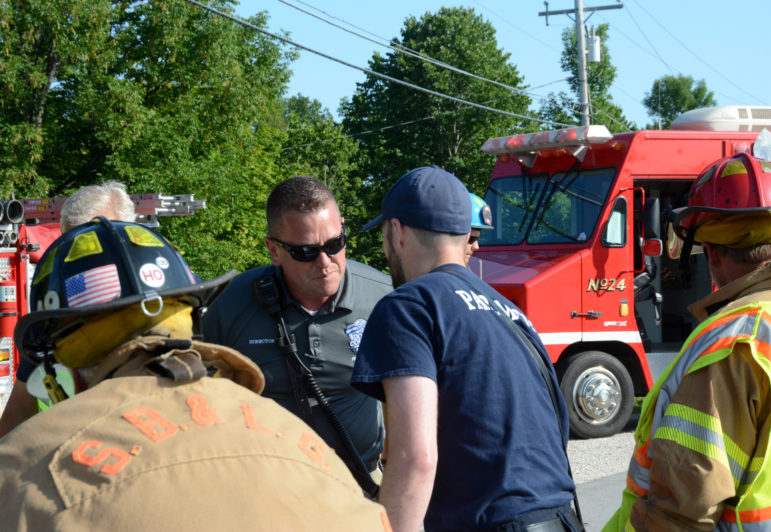
Rural EMS providers say they are concerned about spreading COVID-19 to their families.
“My worry is I’m the one that is coming in and out of my home right now,” said Ashley Carothers, an emergency medical responder for one rural Wisconsin EMS provider. “If my kids contract it, I know it’s going to be because of me. If my husband contracts it, I know it’s going to be because of me.”
Carothers’ boss requested she not share the name of her provider.
“We don’t want to create more panic than we already have,” Carothers said.
Carothers described extraordinary lengths to prevent the coronavirus from entering her household. That begins at the station, where she is able to shower and change clothes after responding to a call. Once home, she puts her clothes in a plastic bag in a backyard shed, and heads straight to the shower, she said. She later washes the clothes, destroys the plastic bag and disinfects her truck.
LeClair said his Door County service is implementing new cleaning measures for trucks, equipment and the workers themselves after shifts.
Puls, the Bayfield County paramedics coordinator, said he has redesigned life inside his home to keep his partner virus-free. They now use separate bedrooms and bathrooms, and tape on the kitchen floor marks his partner’s safe zone for cooking.
“This is enormous. This is bigger than any single event that we’ve ever taken on,” he said. “I think that’s true for all the ambulance services in the state.”
Fear of the unknown makes responding to the pandemic tougher, Puls said. But talking about that fear can help conquer it.
“Fear can become crippling and our group here, the ambulance service, we don’t want to be crippled. We want to be on our game, ready to go,” he said. “That’s what we’re here for.”
This story comes from a partnership of Wisconsin Watch and Wisconsin Public Radio. Bram Sable-Smith is WPR’s Mike Simonson Memorial Investigative Fellow embedded in the newsroom of Wisconsin Watch (wisconsinwatch.org), which collaborates with WPR, PBS Wisconsin, other news media and the University of Wisconsin-Madison School of Journalism and Mass Communication. All works created, published, posted or disseminated by Wisconsin Watch do not necessarily reflect the views or opinions of UW-Madison or any of its affiliates.

